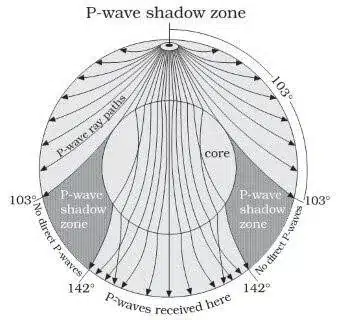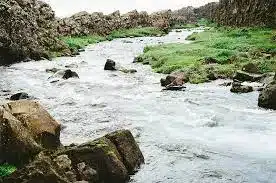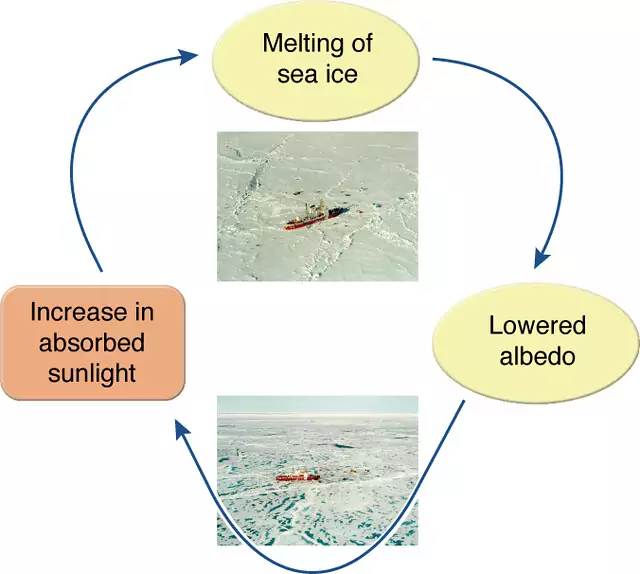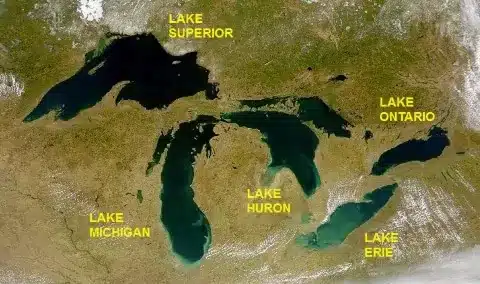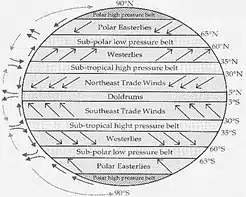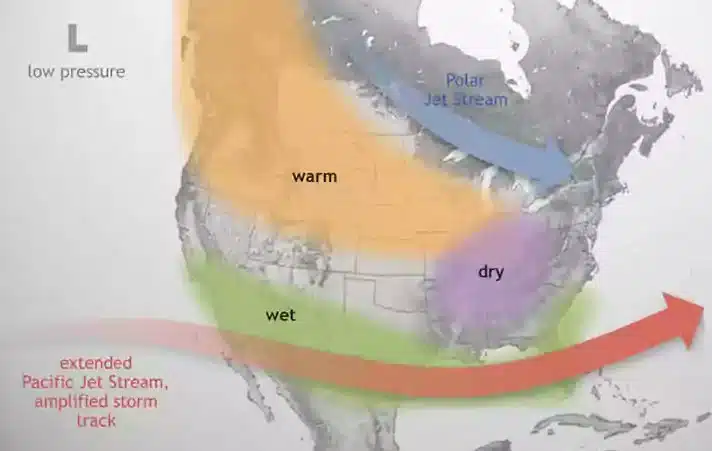Soils In India
- Soil is the mixture of rock debris and organic materials which develop on the earth’s surface.
- The major factors affecting the formation of soil are relief, parent material, climate, vegetation and other life-forms and time.
- Besides these, human activities also influence it to a large extent. Components of the soil are mineral particles, humus, water and air.
- The actual amount of each of these depend upon the type of soil.
- Indian soils can broadly be divided into soils of peninsular India and soils of extra-peninsular India.
- The soils of Peninsular India are formed by the decomposition of rocks in situ, i.e. directly from the underlying rocks.
- The soils of the Extra-Peninsula are also called as transported or azonal soils. They formed due to the depositional work of rivers and wind.
Types of Soils in India
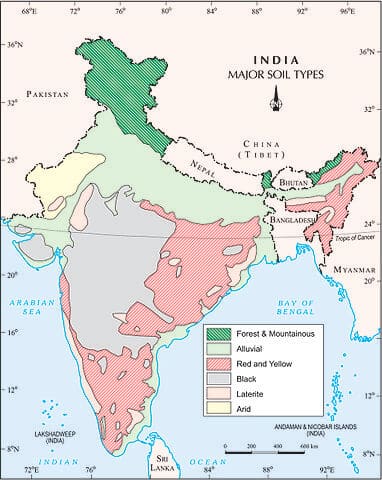
Alluvial Soil: Soils In India
- Found along the Indo-Gangetic-Brahmaputra plains except in few places where the top layer is covered by desert sand and in the Narmada, Tapi valleys and Northern parts of Gujarat. Occur in deltas of the Mahanadi, the Godavari, the Krishna, and the Cauvery, where they are called deltaic alluvium (coastal alluvium).
- They are generally rich in potash but poor in phosphorous. The proportion of nitrogen is generally low.
- Two different types of alluvial soils have developed in the upper and middle Ganga plains, Khadar and Bhangar. Khadar (the new alluvium) is deposited by floods annually, which enriches the soil by depositing fine silts.
- Bhangar (the older alluvium), deposited away from the flood plains.
- Both the Khadar and Bhangar soils contain calcareous concretions (Kankars).
- Immature and have weak profiles due to their recent origin.
- Largest soil group covering about 15 lakh sq km or about 46 percent of the total area.
- The colour of the alluvial soils varies from the light grey to ash grey.
- They yield splendid crops of rice, wheat, sugarcane, tobacco, cotton, jute, maize, oilseeds, vegetables, and fruits.
Black Soil: Soils In India
- Spread over 46 lakh sq km (16.6 percent of the total area) across Maharashtra, Madhya Pradesh, parts of Karnataka, Telangana, Andhra Pradesh, Gujarat, and Tamil Nadu.
- The black soils are rich in lime, iron, magnesia, and alumina.
- They also contain potash. But they lack in phosphorous, nitrogen and organic matter.
- The black colour is due to the presence of titaniferous magnetite compounds of iron and aluminum etc.
- These soils are also known as the ‘Regur Soil’ or the ‘Black Cotton Soil’. The black soils are generally clayey, deep, impermeable and having more water storage capacity.
- These soils have been formed by the disintegration of basaltic lava.
- The colour of the soil ranges from deep black to grey.
- These soils are Zonal Soils.
Red and Yellow Soil: Soils In India
- Soils mainly found in Peninsular India.
- They cover almost the whole of Tamil Nadu, Karnataka, Andra Pradesh, and Odisha.
- Also found in Santhal Pargana and Chotanagpur plateau of Jharkhand.
- These soils lack nitrogen, phosphorous and humus.
- Red soil develops on crystalline igneous rocks in areas of low rainfall.
- The soil develops a reddish colour due to a wide diffusion of iron in crystalline and metamorphic rocks. It looks yellow when it occurs in a hydrated form.
- The fine-grained soils are normally fertile, whereas coarse-grained soils found in dry upland areas are poor in fertility.
- Mainly coarse grains, pulses, and oilseeds are cultivated.
Laterite Soil: Soils In India
- Found mainly on the Eastern and Western Ghats.
- Hilly areas of Rajmahal, Kerala, Karnataka.
- Plateau regions of Odisha, pat plateaus of Chotanagpur and plateaus of Meghalaya.
- Their largest expansion is in Kerala.
- These soils are poor in organic matter, nitrogen, phosphate, and calcium, while iron oxide and potash are in excess.
- Formed due to alternate wet and dry seasons.
- The laterite soils develop in areas with high temperatures and high rainfall.
- With rain, lime and silica are leached away, and soils rich in iron oxide and aluminum compounds are left behind.
- The paucity of lime makes these soils acidic.
- The soil is less fertile, however, the application of manures and fertilizers is required for making the soil fertile for cultivation.
- More suitable for tree crops like cashew nuts, tea, etc.
Desert or Arid Soil: Soils In India
- The arid region of western Rajasthan.
- Iron and Phosphorous are enough but there is a deficiency of nitrogen and humus.
- They are generally sandy in structure and saline in nature.
- Lower horizons of the soil are occupied by ‘kankar’ layers because of the increasing calcium content downwards.
- The ‘Kankar’ layer formation in the bottom horizons restricts the infiltration of water.
- These are infertile soils that are alkaline in nature.
- Coarse Cereals such as jowar, bajra, ragi, etc and oilseeds are produced in these soils.
Mountain or Forest Soil: Soils In India
- Regions of mountains and forest areas, an example in J&K, Himachal Pradesh, Uttarakhand, Sikkim, Arunachal Pradesh, etc
- These soils are poor in Potash, Phosphorus, and lime.
- The soil becomes acidic due to the formation of humic acid( Caused due to undecomposed organic matter)
- They are loamy and silty on valley sides and coarse-grained in the upper slopes.
- In the snow-bound areas of the Himalayas, they experience denudation and are acidic with low humus content.
- The soils found in the lower valleys are fertile.
- These soils are affected by the problem of erosion.
- Plantation of tea, coffee, spices, and fruits are done in these types of soils.
Saline and Alkaline Soil: Soils In India
- Saline soils are more widespread in western Gujarat
- Deltas of the eastern coast and in Sunderban areas of West Bengal.
- Saline soils contain a larger proportion of sodium, potassium and magnesium.
- They lack nitrogen and calcium.
- These soils are also called as ‘Reh’, ‘Usar’ or ‘Kallar’
- They occur in arid and semi-arid regions, and in waterlogged and swampy areas. Their structure ranges from sandy to loamy.
- In the areas of intensive cultivation with excessive use of irrigation, especially in areas of the green revolution, the fertile alluvial soils are becoming saline. Example Punjab and Haryana.
- These are intra-Zonal soils
- In coastal areas, the coconut trees are found in plenty in these areas.
Peat or Organic Soil: Soils In India
- It occurs widely in the northern part of Bihar, the southern part of Uttaranchal and the coastal areas of West Bengal, Orissa, and Tamil Nadu.
- Rich in Humus & organic content, Sometimes alkaline too
- Heavy, Dark & acidic.
- They are found in the areas of heavy rainfall and high humidity, where there is a good growth of vegetation.
- A large quantity of dead organic matter accumulates in these areas, and this gives rich humus and organic content to the soil.
- Soils are normally heavy and black in colour.
Also, refer:

